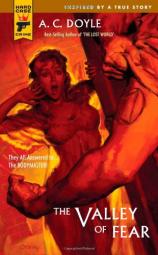The Valley of Fear
Review
The Valley of Fear
When we think of hardboiled, noir crime fiction, the mean
streets of urban America of the 20th century come to mind. We do
not imagine mutton chop whiskers, capes, or hansom carriages. The
latter were part of Sherlock Holmes’s Victorian England.
So when Hard Case Crime recently released a book by A. C. Doyle
called THE VALLEY OF FEAR, eyebrows were raised, my dear Watson.
Yes, it contained the trademark lurid cover with the beautiful --
if somewhat terrified --- young lady in a diaphanous gown. But who
was the author? Further inspection revealed that the writer was
indeed Arthur Conan Doyle, inventor of the most famous detective in
the history of mystery novels. THE VALLEY OF FEAR was the last
Sherlock Holmes novel that the famous writer penned in 1914,
originally as a magazine serialization.
Since it launched in 2004, Hard Case Crime has performed an
invaluable service for mystery fans by reprinting long-lost
classics from the pulp era along with the work of the new
generation of hardboiled masters. But Sir Arthur? His creation,
Holmes, was synonymous with the reason and rationality of the 19th
century deductive scientific method. American pulp fiction
reflected an alienated world where science facilitated barbarism
and mass murder. Things in noir rarely are what they seem and often
don’t even have to make sense. Happy endings are not
necessarily a return to the status quo but just physically
surviving.
Charles Ardai, founder and editor of Hard Case Crime, has an
explanation. He says, “Like many mystery readers, I was a fan
of Sherlock Holmes before I ever read Hammett and Woolrich and
Chandler; he was one of my gateway drugs, if you will, into the
world of crime fiction.” Ardai is an encyclopedia of
knowledge about the pulps: “Now, the Holmes stories might not
seem on first glance to fit into a line that exists to celebrate
the lurid, sexy pulp paperbacks of the 1940s and ’50s, but
actually one of the things the paperback publishers of that time
did was to reprint works of classic literature behind steamy covers
in an attempt to lure unwary readers into picking up a classic they
might not otherwise try.”
THE VALLEY OF FEAR is Ardai’s attempt to do that today,
hence the use of A. C. Doyle to “force readers to take a
fresh look at this most pigeonholed of authors.” And it
works. The book is certainly one of Doyle’s most fascinating
Holmes cases. Unlike the recently released movie in which Robert
Downey, Jr. reinvented Holmes as more of an action figure, the
first half of this novel gives us the classic Holmes whom readers
have come to love and expect.
So there is the murder in a Sussex manor house, complete with
filled moat, scary gables and eight servants. The lord of this
particular manor, a transplanted American of all things, just
happened to get his head blown off in his study by a shotgun. It is
an impossible case; with the drawbridge raised, the killer seems to
have vanished into thin air at amazing speed. And like the dog that
didn’t bark, Holmes uses his powers of reason and observation
to focus on the missing dumbbell.
He solves the case quickly enough, but then readers in 1914 must
have gotten a jolt as the story switched to America. Watson tells
us a flashback story from 20 years previous about an American
Pinkerton detective sent undercover to the mining region of
Pennsylvania to infiltrate a secret criminal gang suspiciously like
the real-life Molly Maguires. The gang is led by one
“Bodymaster” McGinty, who is a cross between a Chicago
ward pol and Attila the Hun.
Now leaving aside the historical question of whether the real
Mollys might have included Irish Catholic workers trying to
legitimately form unions, who were then categorized and prosecuted
as murderous criminals by mine owners and complicit media,
Doyle’s tale is fascinating for two reasons. First, his hero
is a Pinkerton, which the founding father of hardboiled detective
fiction, Dashiell Hammett, was in real life (the Pinkertons were
also notorious strike breakers and union busters of that time).
That is an amazing irony. Second, Doyle’s writing here is
pure hardboiled. He takes us far from the drawing rooms of Baker
Street.
And while Holmes solves the case, there is a hopeless feel to
the entire matter. Holmes concludes: “You heard me warn this
man at Birlstone Manor House that the coming danger was greater
than the past. Was I right?” He certainly was, as usual.
Perhaps writing on the eve of the madness and industrial slaughter
of the First World War, A. C. Doyle was anticipating the noir world
about to be born.
THE VALLEY OF FEAR is a classic read that deserves to be
rediscovered and enjoyed by a new generation of mystery readers.
And yet once again, Hard Case Crime has proven why it is the most
innovative publishing house of the last decade.
Reviewed by Tom Callahan on January 24, 2011
The Valley of Fear
- Publication Date: November 24, 2009
- Genres: Fiction, Hard-boiled Crime Fiction
- Mass Market Paperback: 224 pages
- Publisher: Hard Case Crime
- ISBN-10: 084396295X
- ISBN-13: 9780843962956



